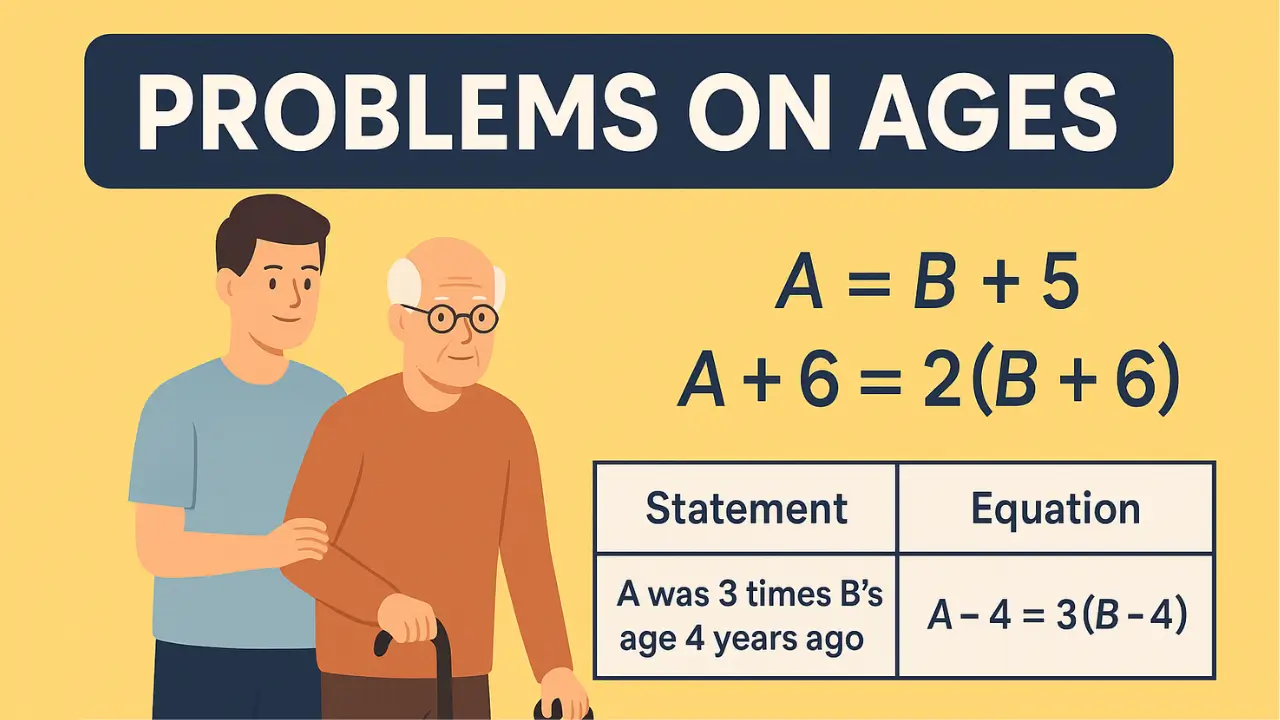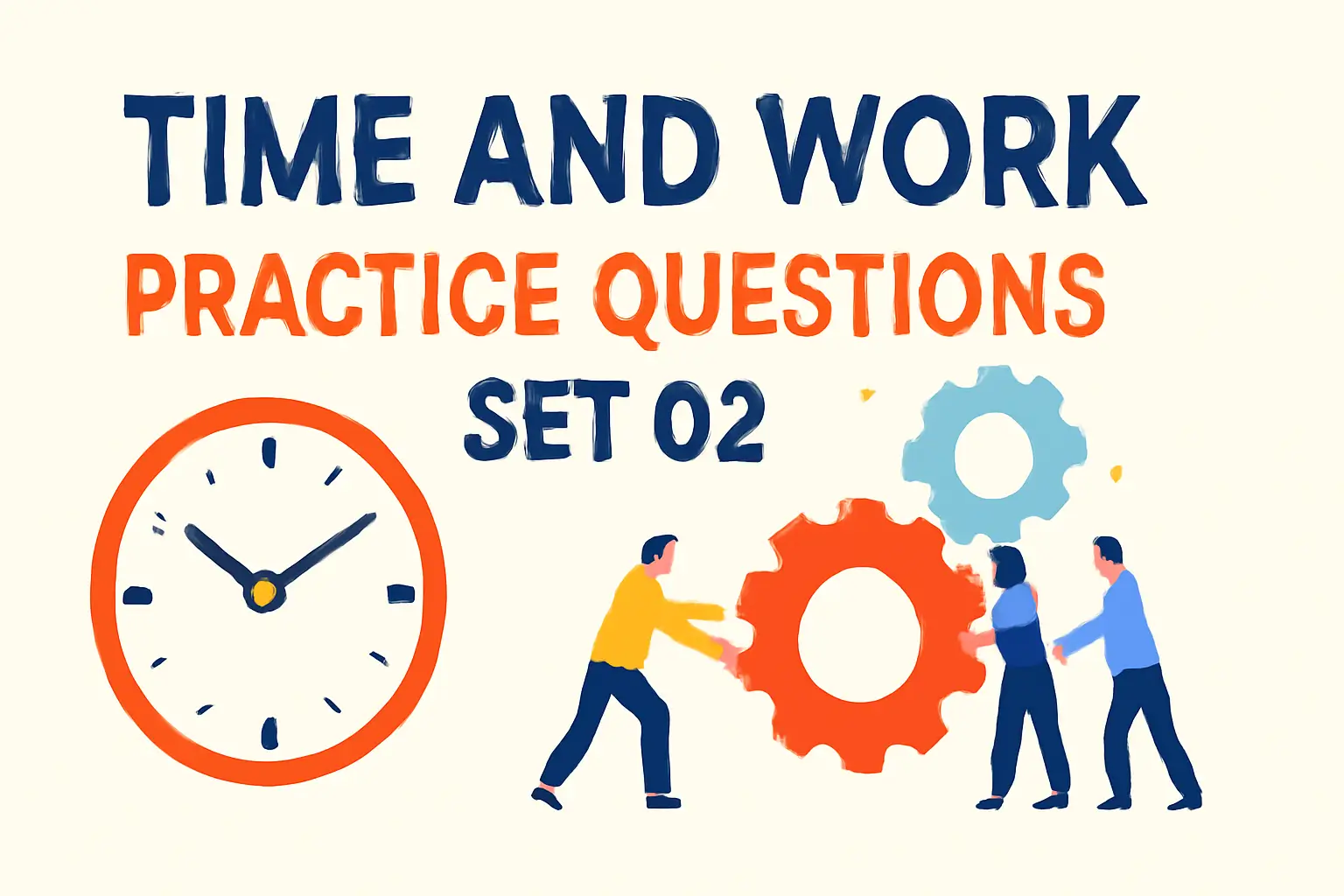Master the basic concept of problems on ages with definitions, examples, formulas, and practice questions with answers. Ideal for competitive exams like SSC, Banking, and Railways.
Why Learn Problems on Ages?
- Frequently asked in almost every aptitude test.
- Questions are simple but can be tricky.
- Can be solved in less than a minute with proper understanding.
- Improves logical and algebraic thinking.
Basic Terms Used in Problems on Ages:
| Term | Meaning |
|---|---|
| Present Age | The current age of the person |
| Age X years ago | Subtract X from present age |
| Age X years later | Add X to present age |
| Twice/Thrice | Multiply the age accordingly |
| Difference of Ages | Remains constant over time |
Let’s understand these with simple examples.
Key Concept: Age Relations:-
1. Present, Past, and Future Age:
If someone’s age is A now:
- Age X years ago = A – X
- Age X years after = A + X
2. Constant Difference Rule:
The difference in age between two people is always constant, regardless of the time.
For example:
If A is 30 and B is 25,
Difference = 5
After 10 years, A = 40, B = 35 → Still difference = 5
Types of Problems on Ages:–
There are mainly 4 types of problems on ages:
Type 1: Based on Present Age:
Example: A is 5 years older than B. If A is 21, what is B’s age?
Solution: B = 21 – 5 = 16
Type 2: Based on Age Before or After Some Years:
Example: 5 years ago, A was twice as old as B. A is 30 now. Find B’s present age.
Solution:
5 years ago → A = 25, B = 12.5
Present age of B = 12.5 + 5 = 17.5 years
Type 3: Age Ratios:
Example: The ratio of ages of A and B is 3:4. After 5 years, it will be 4:5. Find present ages.
Solution:
Let present ages be 3x and 4x
(3x + 5)/(4x + 5) = 4/5 → Solve for x
5(3x + 5) = 4(4x + 5)
15x + 25 = 16x + 20 → x = 5
A = 15, B = 20
Type 4: Based on Average Ages or Groups:
Example:
The average age of a father and his two sons is 22. If the father is 38, what is the average age of sons?
Solution:
Total age = 22 × 3 = 66
Sons’ total age = 66 – 38 = 28
Average age of sons = 28 / 2 = 14
Quick Tricks for Problems on Ages:-
- Always assume variables for unknown ages (like x, y).
- Translate statements into equations.
- Use basic arithmetic: addition, subtraction, ratios.
- Age difference stays the same across years.
- Check options when solving MCQs to save time.
Example Table: Age Questions and Equations:-
| Statement | Equation |
|---|---|
| A is 5 years older than B | A = B + 5 |
| A was 3 times B’s age 4 years ago | A – 4 = 3(B – 4) |
| After 6 years, A will be twice B | A + 6 = 2(B + 6) |
| Sum of ages of A and B is 40 | A + B = 40 |
Practice Questions on Problems on Ages:-
Question 1:
The present age of a father is three times that of his son. After 5 years, the father’s age will be twice that of his son. Find their present ages.
Options:
A) 30 and 10
B) 40 and 20
C) 45 and 15
D) 36 and 12
Answer: C
Explanation:
Let son’s age = x
→ father = 3x
After 5 years: 3x + 5 = 2(x + 5)
3x + 5 = 2x + 10
→ x = 5
So, son = 15, father = 45
Question 2:
The sum of the ages of A and B is 50. After 5 years, the ratio of their ages will be 6:5. Find their present ages.
Answer:
Let A = x → B = 50 – x
After 5 years: (x + 5)/(55 – x) = 6/5
Cross-multiply and solve:
5(x + 5) = 6(55 – x)
5x + 25 = 330 – 6x
→ 11x = 305
→ x = 27.73
A = 27.73, B = 22.27 (approx.)
Question 3:
A’s age is twice that of B. 10 years ago, A was three times as old as B. What are their ages?
Answer:
Let B = x → A = 2x
10 years ago: 2x – 10 = 3(x – 10)
2x – 10 = 3x – 30 → x = 20
B = 20, A = 40
Question 4:
The average age of 3 friends is 24 years. One of them is 28, and the second is 22. What is the age of the third?
Answer:
Total age = 24 × 3 = 72
Age of third = 72 – (28 + 22) = 22
Question 5:
If the ratio of father and son’s age is 7:3 and the difference of their age is 24 years, what is the father’s age?
Answer:
Let ages be 7x and 3x
Difference = 4x = 24 → x = 6
Father’s age = 7x = 42
Common Mistakes to Avoid:-
- Misreading “before” and “after” years.
- Forgetting to add/subtract the years in future/past questions.
- Ignoring that difference of age remains constant.
- Not translating word problems into equations properly.
Conclusion:-
Mastering the basic concept of problems on ages is all about practice and understanding how age relationships work with time. Start with easy examples and move to ratio-based or average-based problems. These questions often look confusing due to the wording, but once you understand the pattern, they become easy to solve in less than a minute.
Keep Practicing Problems on Ages and you’ll find them to be the most scoring part of any quantitative section.
Related Topics:-
- Ratio and Proportion Practice Questions
- Speed Distance Time Questions for Practice
- Compound Interest Practice Questions
Follow Us on Facebook:
Stay updated with the latest math practice sets, tips, and exam strategies. Follow Mathsmine on Facebook for Daily Updates







